Introduction
The field of medical oncological imaging is experiencing a significant disruption with the advent of molecular imaging techniques that are aimed toward earlier detection as well as better characterization and monitoring of cancer [1-3]. Several types of medical imaging modalities are equipped with molecular imaging capabilities and are progressing towards mainstream cancer diagnostics [4,5]. They all share similar challenges in terms of regulatory, and reimbursement hurdles for clinical translation, and ultimately which imaging technique adds more value to the current standard of cancer care relies on its potential for global adoption. With increased affordability, availability, and portability of ultrasound machines, clinical ultrasound has now been deemed as a valuable diagnostic tool for resource-limited settings by the ministries of health in low and middle income countries, several nongovernmental organizations and the World Health Organization [6]. Therefore, technologies that can leverage ultrasound imaging platforms can potentially be adopted widely and more quickly compared to imaging technologies that are capital-intensive. Emerging techniques such as ultrasound molecular imaging [7-10], and ultrasound elastography [11-15] which are currently available as add-on features for ultrasound scanners have shown promise for early and more accurate detection of cancer compared to standard anatomical ultrasound.
Photoacoustic imaging is a hybrid technique that exposes the tissue with a laser and measures optically induced ultrasound signals [16,17]. Therefore, hardware unification of a clinical ultrasound scanner with an appropriate laser source will essentially result in a combined ultrasound and photoacoustic imaging device. In photoacoustic imaging, tissue absorbs pulsed near-infrared light and emanates ultrasound waves as it undergoes transient thermoelastic expansion. The photoacoustic conversion is proportional to the optical absorption and therefore individual tissue constituents that absorb light at different wavelengths can be selectively imaged with photoacoustic imaging (spectroscopy). For example, with angiogenesis being one of the hallmarks of cancer [18], spectroscopic photoacoustic imaging can reveal tissue physiology and help detect neoangiogenesis based on the differences in the absorption of hemoglobin in cancerous tissue compared to the surrounding normal tissue [19]. Moreover, the discovery of cancer biomarkers and molecular targeted contrast agents [20] is streamlining the efforts to detect cancer earlier and more accurately. By using molecularly targeted contrast agents with dyes or agents with known optical absorption properties, molecular photoacoustic imaging can be performed. These physiological and molecular capabilities of photoacoustic imaging have drawn a considerable interest in the medical imaging community resulting in many publications and patents.
In this review, the current status of clinically translatable state-of-the-art photoacoustic imaging techniques and some of the key outcomes pertaining to different cancer applications along with challenges and possible solutions are discussed.
Basics of Photoacoustic Imaging
The conversion of light to sound is called photoacoustic effect and has been first introduced by Alexander Graham Bell in 1880 [21]. When a tissue is exposed to high energy, short duration (nanoseconds) pulses of electromagnetic radiation such as laser light, it undergoes optical absorption which in turn causes localized heating and rapid thermoelastic expansion producing transient broadband ultrasound waves (Fig. 1). Since these ultrasound (-acoustic) waves are a result of tissue optical (-photo) absorption, they are generally referred to as photoacoustic waves and the technique of reconstructing the images from the signals corresponding to these photoacoustic waves is called photoacoustic (or optoacoustic) imaging [22]. Because photoacoustic imaging relies on light propagation only one-way and the detection is based on ultrasound generation, deeper tissue penetration is possible compared to traditional optical imaging techniques. Ultrasound scattering is two to three orders of magnitude weaker than optical scattering in tissue [17] allowing deeper tissue imaging and, therefore, provides images with high spatial resolution representing tissue optical absorption. Moreover, as the image formation is based on tissue absorption rather than scattering, the photoacoustic images are also free of speckle which is commonly seen on ultrasound [23]. With other obvious advantages like nonionizing laser radiation, affordability and ease of integration into clinical ultrasound scanners, and the ability to provide physiological information leveraging endogenous tissue contrast, photoacoustic imaging can potentially transform the clinical imaging landscape by complementing existing techniques for improved cancer imaging.
A typical biomedical photoacoustic imaging system consists of a pulsed tunable near infrared (NIR) wavelength laser with pulse width (<10 nanoseconds), fluence (20-100 mJ/cm2 at 700-1,100 nm) and pulse repetition frequency (PRF; 10 Hz-50 Hz) to achieve high quality real-time images of tissue. The NIR wavelength range is important for medical imaging because the optical absorption by tissue is minimal in this spectrum allowing the light to penetrate deeper into the tissue [24]. Shorter pulse widths ensure that the stress and thermal confinement conditions are met warranting the photoacoustic effect while higher fluence (energy delivered per unit area) yields better imaging depth and increased photoacoustic signal generation in tissue. There is no hard limit for the PRF except that the higher rates account for faster imaging time, and thus are better for clinical applicability.
Typically, the photoacoustic waves that are generated from an optical absorption event propagate away from the source as spherical transients and can be detected using an ultrasound transducer placed at a distance (over the surface of the skin). Consequently, the most common and affordable approach to build a photoacoustic imaging system is to modify a clinical ultrasound scanner by integrating it with a pulsed NIR laser with an appropriate light delivery mechanism to stimulate the tissue and detect the photoacoustic waves simultaneously [25]. The key is to synchronize the transducer acquisition time with laser firing to ensure accurate registration and spatial localization of the absorption event. Since a clinical ultrasound scanner is already equipped for ultrasound imaging, this approach has the advantage of providing co-registered ultrasound B-mode and photoacoustic images simultaneously. A key limitation, however, is that a traditional ultrasound transducer array can only detect a portion of the spherical photoacoustic transients posing a tradeoff in image contrast (Fig. 2). Alternatively, an approach called photoacoustic computed tomography [26] can result in the acquisition of a larger portion of the signal either by mechanically scanning a focused ultrasound transducer over the tissue or using transducers arranged in a curved array around the tissue coupled with an image reconstruction scheme where photoacoustic signals from all the transducer elements are filtered, back-projected and added to form a final image similar to X-ray computed tomography. This allows greater control over photoacoustic data acquisition providing time-dependent radiofrequency (containing amplitude, phase, and frequency) data that can be used for image quantification. However, photoacoustic tomography often requires a dedicated photoacoustic imaging system due to the transducer arrangement necessitating custom hardware and software for image reconstruction.
Another decisive step from the application standpoint is the selection of imaging wavelengths. Optical absorption of tissue constituents is discrete at NIR wavelengths ranging from 700 to 1,100 nm where light penetration of up to several centimeters is possible [27,28]. Spectroscopic photoacoustic imaging employs multiple wavelengths of laser light to determine the relative concentrations of specific chromophores in tissue such as hemoglobin, lipid, water, melanin, and collagen among others [19,29-33]. This ability to spectrally resolve relative amounts of deoxygenated and oxygenated hemoglobin to determine hemoglobin concentration and oxygen saturation for example [34], has been the basis for several studies aiming to characterize cancerous tissue which is often hypoxic compared to noncancerous tissue [35,36]. Beyond imaging endogenous absorbers, spectroscopic photoacoustic imaging has been investigated to evaluate how certain exogenous contrast agents such as dyes [37-41], nanoparticles [42,43], carbon nanotubes [44], nanodroplets [45,46], liposomes, and polymer particles [39] are biologically processed in vivo and contribute to the overall improvement of photoacoustic image contrast. These exogenous contrast agents when conjugated or encapsulated with suitable antibodies or peptides and administered intravenously, can bind to cancer-specific biomarkers that do not naturally absorb light facilitating photoacoustic molecular imaging [47].
Photoacoustic Imaging of Cancer: Clinical Applications
Photoacoustic imaging has traditionally been implemented with systems that can be broadly categorized into either stand-alone photoacoustic imaging systems with linear/phased array transducers, or photoacoustic computed tomography systems which commonly employ curved array transducers and custom data acquisition units. Many of these systems are being transitioned from their initial prototype design to assume a more practical form factor of clinical ultrasound scanners with handheld probes. A review of selected studies involving cancer patients is provided to give a glimpse of photoacoustic imaging technologies/applications that are clinically translatable, and the readers are encouraged to refer to recent reviews for more information on other applications [16,48-52].
Stand-Alone Photoacoustic Imaging Systems
Photoacoustic imaging has been explored by several investigators for breast imaging as a potential alternative to X-ray mammography which is the standard-of-care screening technique in American women of age 40 years or older [53]. As such, these mammography-alternative devices were often developed under the presumption that the healthcare system will embrace the shift from X-ray mammography to modalities that are comparable in cost, but add significant value to the patient. These photoacoustic mammography systems typically have a patient examination table with an aperture to suspend the patientŌĆÖs breast when lying in prone position. And the laser and detector are arranged underneath the exam table with the breast mildly compressed. One such systems is the photoacoustic mammoscope, a prototype clinical system developed at the University of Twente (Enschede, Netherlands) [54]. This system employs a two-dimensional circular ultrasound detector array (80 mm diameter, 590 elements, 1-MHz center frequency) on one side of the compressed breast with laser exposure (1,064 nm, 10 mJ/cm2) from the other side to facilitate three-dimensional (3D) imaging. Results from a recent clinical study (Fig. 3) with 43 patients (31 malignant, 2 fibroadenomas, 1 chronic inflammation, 5 cysts, and 2 invalid measurements) reported the visualization of tumors with high contrast in 30/31 breast cancer patients (Breast Imaging Reporting and Data System [BI-RADS] density: low [1 or 2] in 23 patients and high [3 or 4] in 8 patients) concluding that the photoacoustic image contrast was independent of the mammographically estimated breast density unlike X-ray mammography [55]. The average scan time with photoacoustic mammoscope was 10 minutes for a field of view of 90├Ś80 mm2. Based on a subjective survey of 30 patients involved in the study, 25 patients indicated their preference to photoacoustic mammography over X-ray mammography in terms of comfort. Upon a formal health technology assessment of photoacoustic mammoscope [56], photoacoustic imaging was further determined as the most promising alternative to the combined use of X-ray mammography and ultrasonography for early stage breast cancer diagnosis.
Another stand-alone photoacoustic imaging system (Canon Inc., Tokyo, Japan) introduced by Kitai et al. [57] is similar to the photoacoustic mammoscope in principle where the patient lies in prone position on the examination table with the breast suspended through a rectangular aperture (17 cm├Ś18 cm) and mildly compressed between two plates craniocaudally underneath the table. Laser delivery (4 wavelengths: 756 nm, 797 nm, 825 nm, and 1,064 nm) onto the breast is achieved through both plates (dual-illumination) while the rectangular detector array (15├Ś23 elements, 1 MHz) is coupled to the caudal plate to facilitate 30 mm├Ś46 mm scans in 45 seconds. A total of 42 lesion-bearing breasts from 40 patients were imaged with this system who also underwent mammography, magnetic resonance imaging, ultrasound, and eventually breast surgery [58]. Histologically, 39/42 lesions were found to be malignant with 33 of them classified as invasive breast cancers while 3/42 were benign. Out of the 39 malignant lesions, 29 lesions (74.4%) were identified to be microvessel rich using photoacoustic imaging. Mean oxygen saturation was also calculated in breast tumors for each patient by processing multi-wavelength images, and all the measured lesions showed lower oxygen saturation levels compared to surrounding vasculature (P<0.001) within the target breast, as well as the normal contralateral breast (P=0.001).
Kim et al. [59] explored the use of photoacoustic imaging to detect breast microcalcifications as an alternative to mammography, avoiding radiation exposure. Twenty-one biopsy cores from 16 patients: 11 cores with microcalcifications from 11 patients suspected to have malignancy by mammography, and 10 cores without microcalcifications from five patients with biopsy-confirmed fibroadenoma, were evaluated using their custom-designed photoacoustic imaging system. The biopsy core specimens were soaked in saline solution for about 6 hours to wash off any blood and imaged with their system (dual wavelength laser: 700 nm and 800 nm, 7 nanoseconds, 10 Hz; detector: 7-MHz linear array scanned along elevation direction to acquire 3D data) in order to spectrally enhance the signal obtained from microcalcifications. Microcalcifications were hypothesized to show a signal with maximum amplitude at 700 nm, and a decreased or diminished amplitude at 800 nm while this difference is expected to be less pronounced in nonmicrocalcifications. Based on the ratio between signals at 700 nm to signals at 800 nm, 10/11 specimens containing microcalcifications (median ratio, 2.46), and 8/10 specimens without microcalcifications (median ratio, 1.10) were correctly identified with their system (P=0.006), when evaluated against specimen mammography results.
The application of photoacoustic imaging to characterize skin lesions was investigated by Favazza et al. [60] using a stand-alone photoacoustic microscopy system which consisted of a dye laser (570 nm and 700 nm, 500 Hz) and a 50-MHz single element ultrasound transducer (V214-BB-RM, Panametrics Inc., Waltham, MA, USA) connected to a motorized translation stage. When the system was utilized to scan the forearm of a human volunteer, it was able to differentiate a benign melanocytic nevus (mole) from the surrounding blood vessels. To acquire a three-dimensional volumetric image of a 6 mm├Ś4 mm area with nevus, it took 5-10 minutes as the system scanned at 20 ╬╝m increments in horizontal and vertical directions. From the photoacoustic images, the dimensions of nevus were measured as 262-270 ╬╝m thick, 2.64-2.66 mm wide, and located 135-140 ╬╝m deep below the skin surface comparable to the histological measurements demonstrating the potential of photoacoustic imaging in detecting skin lesions.
Urological and endocrinological applications of photoacoustic imaging were explored by Dogra et al. [61] using a stand-alone photoacoustic imaging system that can achieve real-time focusing using an acoustic lens instead of traditional electronic focusing methods. The system was reported to employ a tunable pulsed laser (760 nm, 850 nm, 930 nm, and 970 nm) for spectroscopic imaging and a linear ultrasound array (32 elements, 5 MHz) coupled with a data acquisition unit which was capable of 3D volumetric image acquisition. The scan time was estimated as 5 minutes to image an area of 45 mm├Ś45 mm. With this system, the research group performed two independent ex vivo studies involving prostate and thyroid cancer patients. In the prostate study, 42 grossly sectioned prostate specimens were acquired immediately after prostatectomy from 30 patients with biopsy-confirmed prostate cancer [62]. Upon spectroscopic decomposition, photoacoustic images of normal, benign prostatic hyperplasia (BPH), and malignant specimens were reconstructed indicating the presence of deoxyhemoglobin, oxyhemoglobin, lipid, and water. When correlated with histopathology, the results revealed that the system was able to identify 13/16 malignant and 25/26 nonmalignant (BPH and normal combined) prostate samples based on the deoxyhemoglobin signature. Furthermore, significant differences in mean intensity values of deoxyhemoglobin and lipid were reported between malignant and normal prostate. Similarly, substantial differences in mean intensity of deoxyhemolgobin between malignant prostate and BPH was seen while no statistically significant difference in any of the constituents was reported between BPH and normal prostate tissue. Overall, when BPH and normal prostate tissue were considered together as nonmalignant prostate, a statistically significant difference in mean intensity of deoxyhemoglobin was found between malignant and nonmalignant prostate tissue. In the thyroid study [63], spectroscopic photoacoustic imaging was performed immediately following resection of 88 thyroid lesions (13 malignant and 75 benign) harvested from 50 patients who underwent total or partial thyroidectomy. When a similar analysis to prostate study was performed on this dataset, an increase in mean photoacoustic signal intensity of de-oxyhemoglobin was reported in malignant thyroid tissue compared to benign thyroid tissue. The sensitivity and specificity in differentiating malignant from nonmalignant thyroid tissue were reported as 69.2% and 96.9%, respectively.
Likewise, Aguirre et al. [64] have investigated gynecological applications of photoacoustic imaging with their custom-developed photoacoustic imaging system. This system incorporated a pulsed tunable laser (740 nm, 12 nanoseconds, 15 Hz) and a 1.75-dimensional transducer array (5 MHz) and was used to perform an ex vivo study on 33 human ovaries extracted from patients who underwent oophorectomy. Results of their study indicated that it was possible to differentiate normal postmenopausal versus malignant postmenopausal ovaries with a sensitivity and specificity of 83% and 83%, respectively. For clinical use, an upgraded system was later introduced by the investigators [65,66] employing a laser (750 nm, 20 nanoseconds, 15 Hz) and a modified commercial transvaginal ultrasound probe (6 MHz) to accommodate fiber optic cables that can deliver laser onto the ovaries through the probe. However, an in vivo study involving ovarian cancer patients is not yet reported to date.
Cancer of the cervix is another application that has been investigated by Peng et al. [67] who employed a photoacoustic imaging system (532 nm laser delivered through optical fiber with spot size 1 mm) with a 10-MHz focused transducer for signal detection. An in vitro study was carried out on frozen cervical biopsy samples (3-6 mm in size) collected from 30 patients who underwent cervical colposcopical screening. Each frozen sample was divided into two halves, each of which was evaluated by photoacoustic imaging and histopathology (Fig. 4). Each frozen sample consisting of normal tissue and lesion was embedded in a cylindrical agar phantom at a depth of 5 mm from surface to mimic optical properties of the human cervix and was imaged with the system. Histological staging confirmed that there were 1/30 cervical intraepithelial neoplasia (CIN) 2, 6/30 CIN3, 12/30 cervical cancer (CC) 1, 10/30 CC2, and 1/30 CC3 samples (CIN, CC). Upon correlation with histopathology, photoacoustic images indicated an increased mean optical absorption in cervical lesions compared to normal cervical tissue samples. Also, the mean optical absorption was observed to increase monotonically with the severity of lesions yielding a correlation of 94% between staging of CC and the mean optical absorption.
Photoacoustic Computed Tomography Systems
Using a photoacoustic computed tomography approach, Ermilov et al. [68] developed a system called Laser-based Optoacoustic Imaging System (LOIS-64) which employs an annular array of detectors (64 elements) arranged in a hemispherical cup in which the patientŌĆÖs breast is suspended. The system utilizes a NIR laser (755 nm,10 mJ/cm2), and a custom image acquisition and processing system to enable tomography. Results from a clinical study involving 27 patients suggested that 18/20 biopsy-confirmed malignant lesions previously suspected on X-ray mammography and ultrasound were visualized by LOIS-64 [68].
A similar system was developed by Kruger et al. [69] which consists of a Food and Drug Administration (FDA)-approved 756 nm laser and an examination table with circular aperture comprising of a hemispherical array of spirally arranged ultrasound detectors (512 circular elements, 2 MHz). The feasibility of clinical breast imaging with this system utilizing photoacoustic computed tomography was reported using four healthy patients. The scan time with this system was between 12 seconds and 3.2 minutes depending on the active spiral size of the detector ranging from 24-mm to 96-mm radius.
Besides breast imaging application, an ex vivo study of lymph nodes collected from patients with cutaneous melanoma who also underwent lymphadenectomy was reported to stage melanoma [70]. The photoacoustic computed tomography system employed a top-down laser delivery scheme (720 nm, 760 nm, 800 nm, 850 nm, and 12 mJ/cm2) with the sample in between, and the imaging was performed by rotating a curvilinear ultrasound array (32 elements, 6.25 MHz) around the sample. The acquisition time with this system was reported as 4 minutes per wavelength during which 18 projections of each lymph node were acquired to reconstruct a final image. Results from the ex vivo lymph nodes resected from one patient suggested that their system was able to detect strong photoacoustic signal intensity throughout the lymph node which was confirmed as melanoma through histopathology evaluation.
A similar but larger study on 148 sentinel lymph nodes (SLNs) excised from 65 patients was performed using multispectral optoacoustic tomography (MSOT) inVision 128 system (iThera Medical GmbH, Munich, Germany), a commercially available preclinical system to detect melanoma metastasis [71]. 3D multispectral imaging was performed at 10 wavelengths between 700 and 880 nm (PRF 10 Hz, averaged over 25 laser pulses) using an arc-shaped (270o) transducer array (5 MHz, 128 elements). Out of 148 SLNs, 77 SLNs showed a photoacoustic signal corresponding to melanin with 34 of them confirmed as metastatic by histopathology (stained for Melan A). The other 71 SLNs revealed no photoacoustic melanin signal and were deemed to be nonmetastatic histologically, indicating a system sensitivity of 100% and a specificity of 62% in detecting SLNs.
Photoacoustic Imaging Systems Resembling Clinical Ultrasound Scanners
Imagio (Seno Medical Instruments, Inc., San Antonio, TX, USA) was the first photoacoustic imaging system to receive a regulatory clearance (CE mark) and is commercially available in Europe. Imagio is a dual-laser system (1,064 nm and 755 nm) intended for breast cancer diagnosis and is equipped with a handheld commercial linear ultrasound array (128 elements, 5 MHz) to allow real-time data acquisition [72]. Currently, this system is being validated through a large, multi-center prospective clinical trial in the United States with an estimated enrollment of 2,000 breast cancer patients. An interim report of this ongoing trial reported that 66 patients (37 cancers and 29 benign lesions proven histologically) were imaged successfully with a sensitivity and specificity of 100% and 72%-79%, respectively [73,74].
A related application with the goal to noninvasively detect SLNs that can help determine the stage and extent of metastasis of breast cancer was explored on a clinical ultrasound scanner (iU22, Phillips Healthcare, Andover, MA, USA) modified for photoacoustic imaging by incorporating a laser (667 nm, 10 mJ/cm2) and a handheld linear array (4 to 8 MHz) enabling co-registered ultrasound and photoacoustic imaging [75,76]. Sixteen patients with pathologically-confirmed breast cancer scheduled for axillary lymph node dissection were imaged with this system to achieve SLN visualization based on increased contrast from methylene blue injection. The goal of this study was to detect SLNs using an alternative noninvasive, nonionizing approach to the traditional SLN biopsy, an invasive surgical procedure that also involves radioactive colloid injection. In all patients, methylene blue (5 mL, 2 mg/mL) was injected subcutaneously near the areola in the same breast quadrant as the primary tumor and allowed to drain for 5 minutes followed by combined photoacoustic and ultrasound imaging. Thereafter, a small titanium clip was deployed in 13 patients under photoacoustic image-guidance to mark suspected SLNs. After the imaging session, patients underwent conventional SLN biopsy using both methylene blue and radioactive colloid injections. The SLNs were later removed surgically and imaged with specimen radiography followed by histopathological examination (Fig. 5). The presence of titanium clip within the SLN specimen was confirmed in 6/13 patients suggesting the feasibility of photoacoustic imaging in detecting SLNs that can be sampled using minimally invasive fine needle aspiration biopsy to determine breast cancer metastasis.
In a similar SLN study aimed at detection of melanomatic metastasis, 20 patients underwent radioactive lymphoscintigraphy and single-photon emission computed tomography/computed tomography (SPECT/CT) before photoacoustic imaging [71]. For this study (Fig. 6), the authors employed a handheld photoacoustic imaging system with two detector configurations [77]: (1) cylindrically focused 256-element, 4-MHz, arc-shaped (135o) detector array for 25├Ś25 mm2 planar acquisition and (2) semispherical 384-element, 2.5-MHz detector for 20├Ś20├Ś25 mm3 volumetric acquisition. Multispectral imaging was performed at five wavelengths (700, 730, 760, 800, and 850 nm) with one laser pulse per wavelength (PRF 20 Hz). This system is currently available for exploratory clinical use as MSOT Acuity (iThera Medical GmbH) with optional integrated photoacoustic/ultrasound detectors [78,79] and is yet to receive its CE Mark and FDA clearance for commercial adoption. By using Indocynanine Green as localizing contrast agent, photoacoustic imaging was able to visualize 41 SLNs (100%) in 20 patients previously identified with lymphoscintigraphy and SPECT/CT. In addition to SLN detection, the ability of photoacoustic imaging to noninvasively detect melanoma metastases was examined based on melanin content within the node in the same study [71]. Eighteen of 41 SLNs (43.9%) were considered nonmetastatic by photoacoustic imaging and histology, 19/41 (46.4%) showed melanin signal on photoacoustic imaging but stained negative for Melan A (false-positive for metastasis attributed to pigmentation, nevi, melanophages, or hemorrhage), and 4/41 (9.7%) were true-positive as confirmed by histopathology. While radiation-free SLN detection was achieved successfully, the high false-positive rate for metastasis detection emphasizes the need to excise SLNs and perform histopathology assessment for accurate cancer diagnosis until an alternative melanoma-specific contrast agent is available. With no false-negatives reported, a sensitivity of 100% and specificity of 48.6% were reported.
Challenges and Future Outlook
From this review, one can appreciate the complexity of categorizing photoacoustic imaging systems which are evolving into more robust equipment to facilitate clinical adoption. It can also be noted that the majority of the systems discussed here have been designed primarily at academic institutions, with only a few exceptions. These systems are therefore one-of-a-kind prototypes rather than final products. Since these systems were not designed for manufacturability and were developed to demonstrate feasibility with reasonable safety, they suffer from limited standardization across the spectrum making it almost impossible to compare data between the systems posing a didactic challenge for the clinicians, not to mention the regulatory hurdles. Developments in system design to assume the form factor of clinical ultrasound scanners as suggested by recent advances is a step in the right direction to facilitate faster clinical integration filling this void. For photoacoustic imaging systems to be adopted widely, fast lasers [80] that can operate at higher frame rates (hundreds or thousands of Hertz) similar to ultrasound for real-time image acquisition are important along with adequate safety monitoring systems that ensure safe laser-exposure levels to patient and the provider [81].
Another key factor which impacts the clinical adoption is the approval for marketing of the device for a specific clinical indication by regional regulatory bodies such as FDA in the United States and CE Mark in European Union. In light of Affordable Care Act adopted in United States recently which imposes reimbursement penalties to healthcare facilities based on quality metrics, it has become increasingly complex for the medical device companies to bring new technologies for patient care as the healthcare sector is undergoing a major shift from fee-for-service model to value-based model requiring companies to demonstrate value proposition clearly over existing standard-of-care at similar or lower adoption costs. Therefore, it is important that the inventors consider such macroeconomic factors while developing commercial photoacoustic imaging systems in order to ensure a successful clinical translation. Several clinical trials on photoacoustic imaging [82-89] which are currently underway (mostly first-in-human or phase I) focus on critical endpoints to demonstrate feasibility, safety and effectiveness. These trials, if successful, enable the need for subsequent larger phase II clinical trials that need to demonstrate value proposition to establish a robust reimbursement pathway which is a crucial factor for successful clinical adoption in addition to the safety and effectiveness data typically acquired for regulatory purposes. Formal health technology assessment programs which are more common in Europe than in United States [90,91] can be helpful during the early stages of photoacoustic imaging device development to anticipate any costs, challenges and pitfalls upfront and help mitigate the risks associated with business development and clinical adoption.
Conclusion
There is a growing interest in photoacoustic imaging within the key stakeholders including clinicians with several ongoing first-in-human clinical trials, as well as large medical device companies that are cautiously eager to acquire new technologies which are effective, and carry minimal regulatory and reimbursement risks allowing market penetration and adoption. Clinical applications discussed here highlight the potential of clinical photoacoustic imaging to complement ultrasound and other existing armaments to help combat cancer and hopefully ultimately ease its burden on the global healthcare system.



 Print
Print facebook
facebook twitter
twitter Linkedin
Linkedin google+
google+
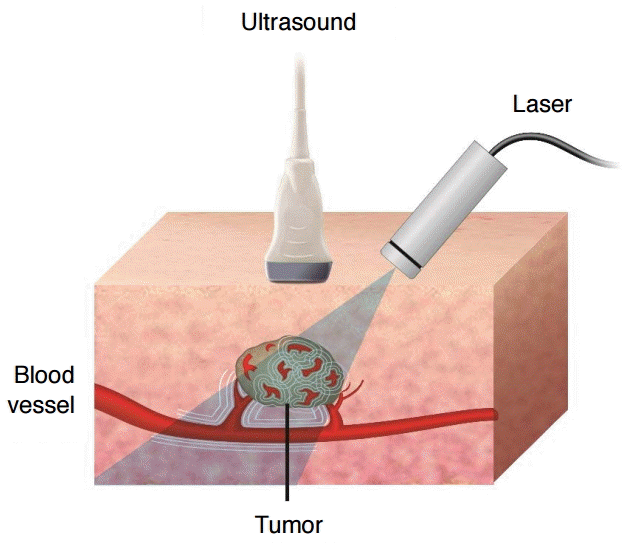
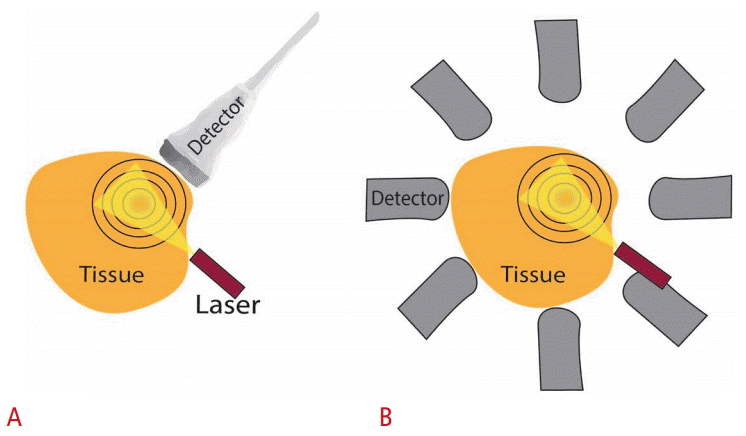
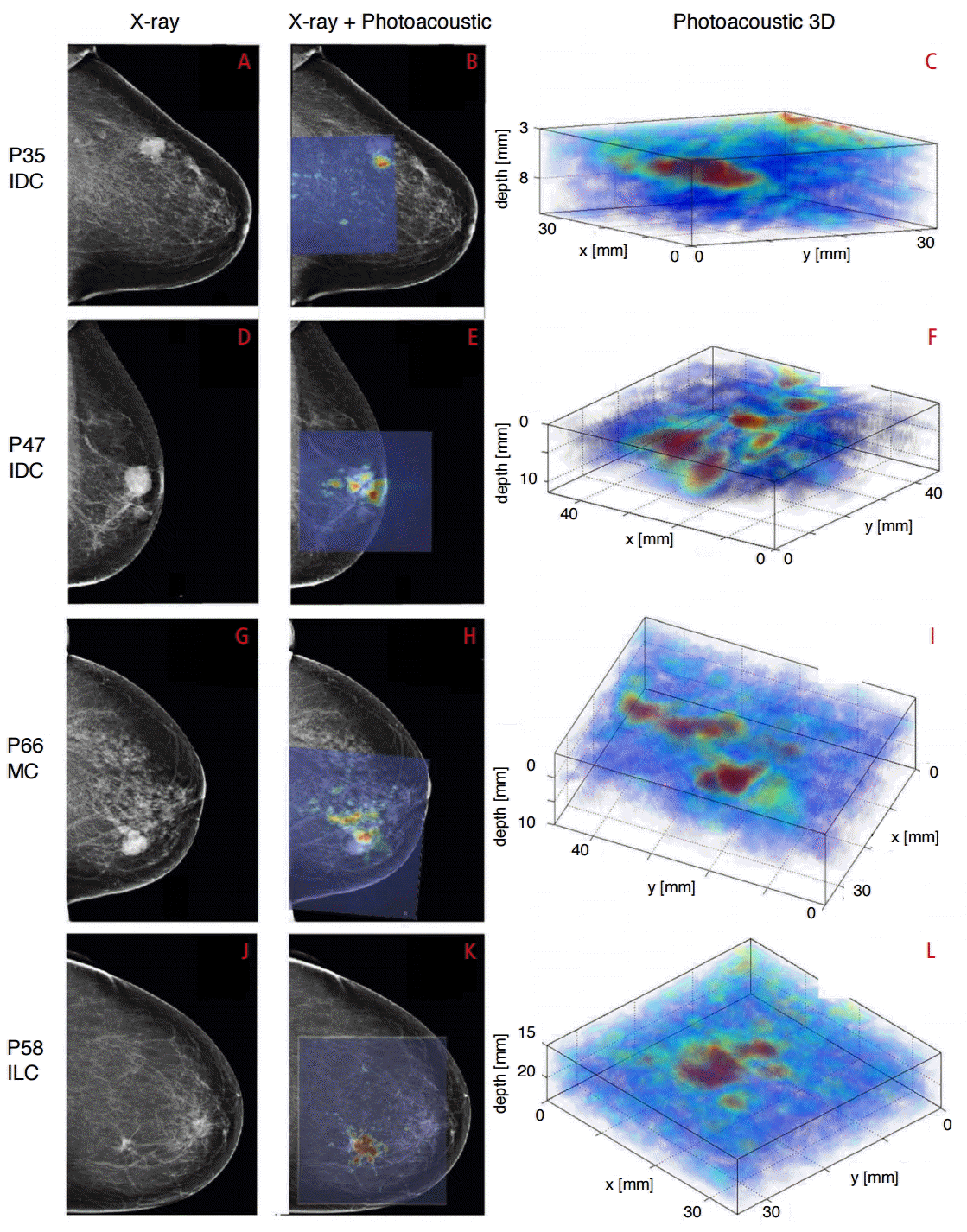
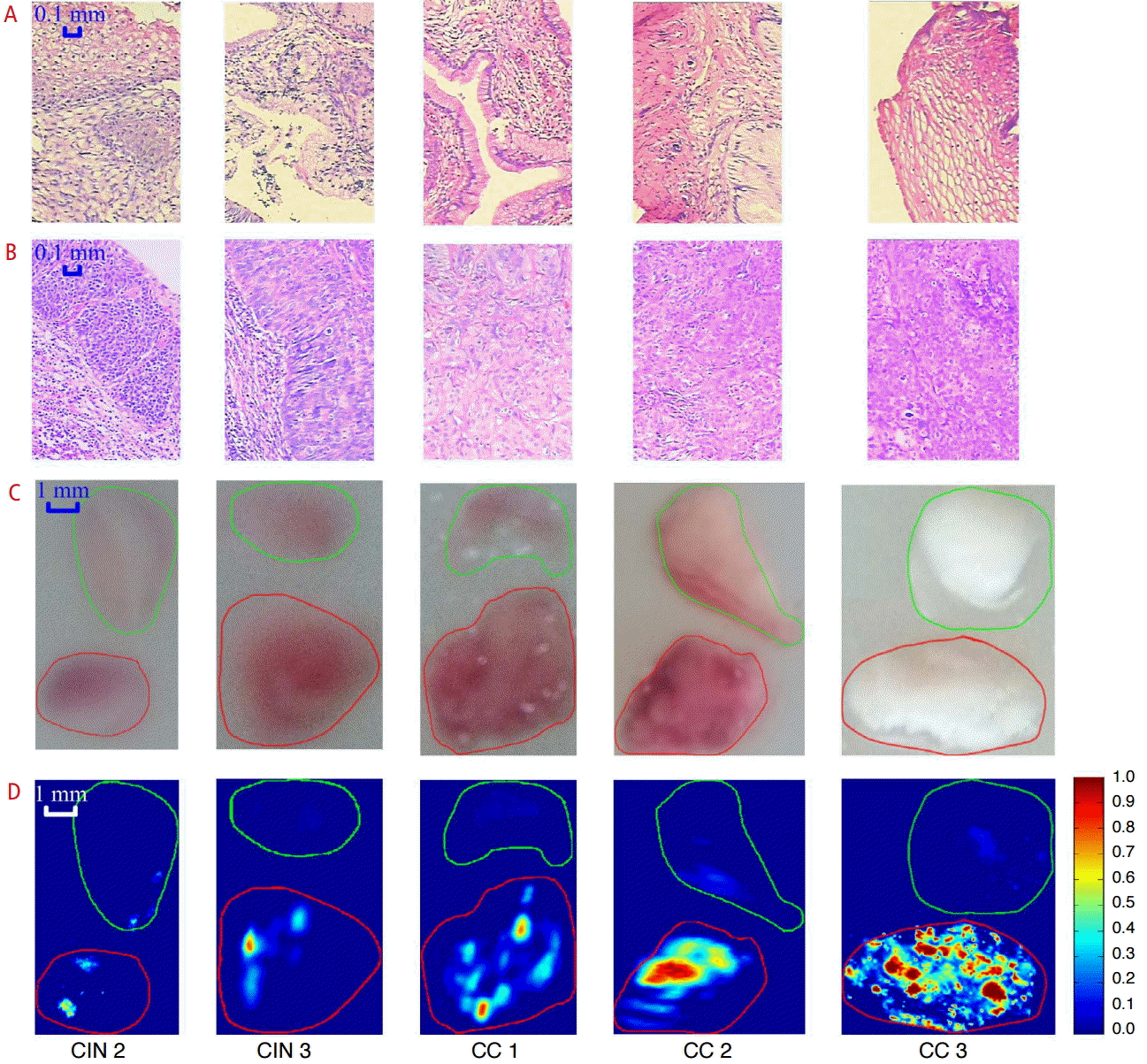
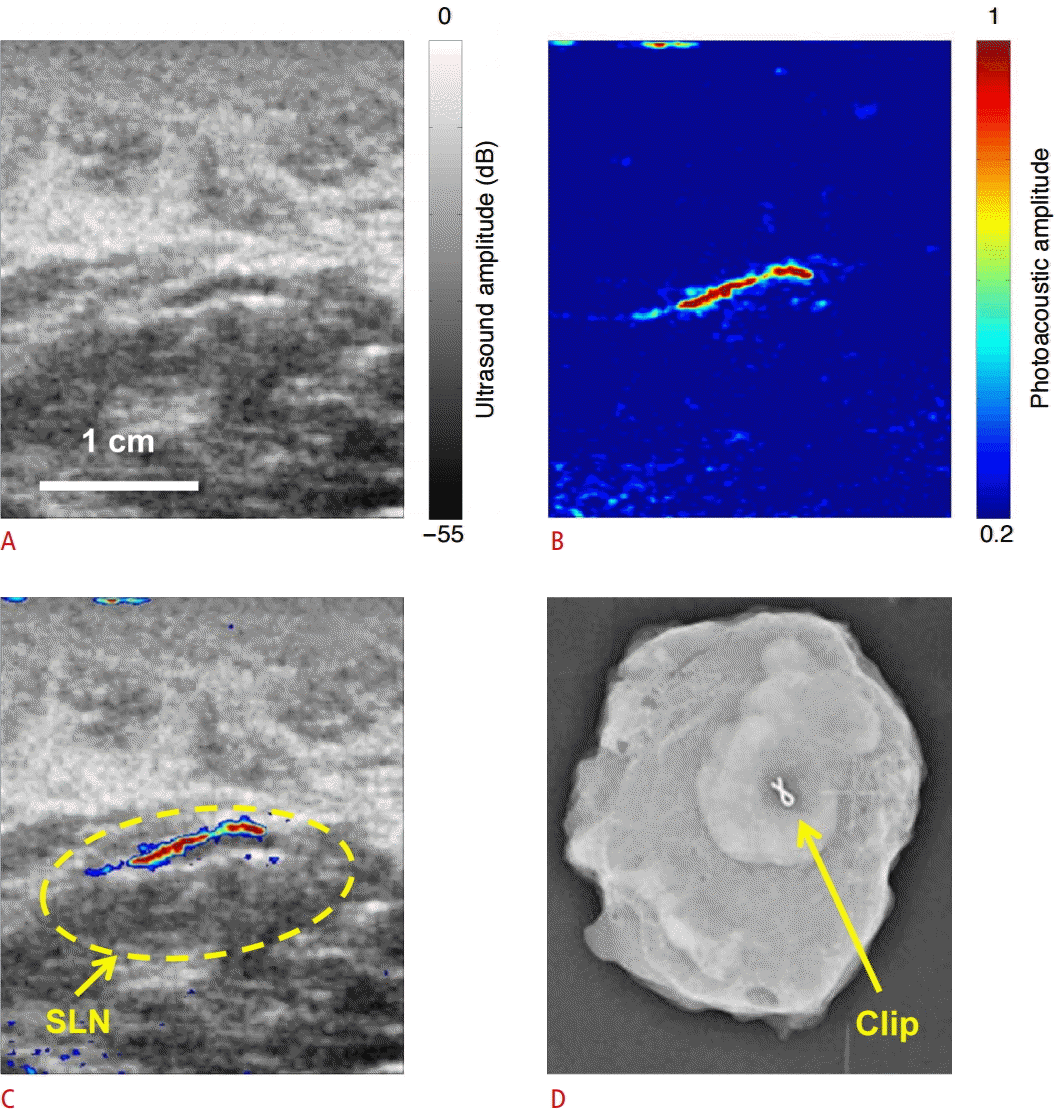
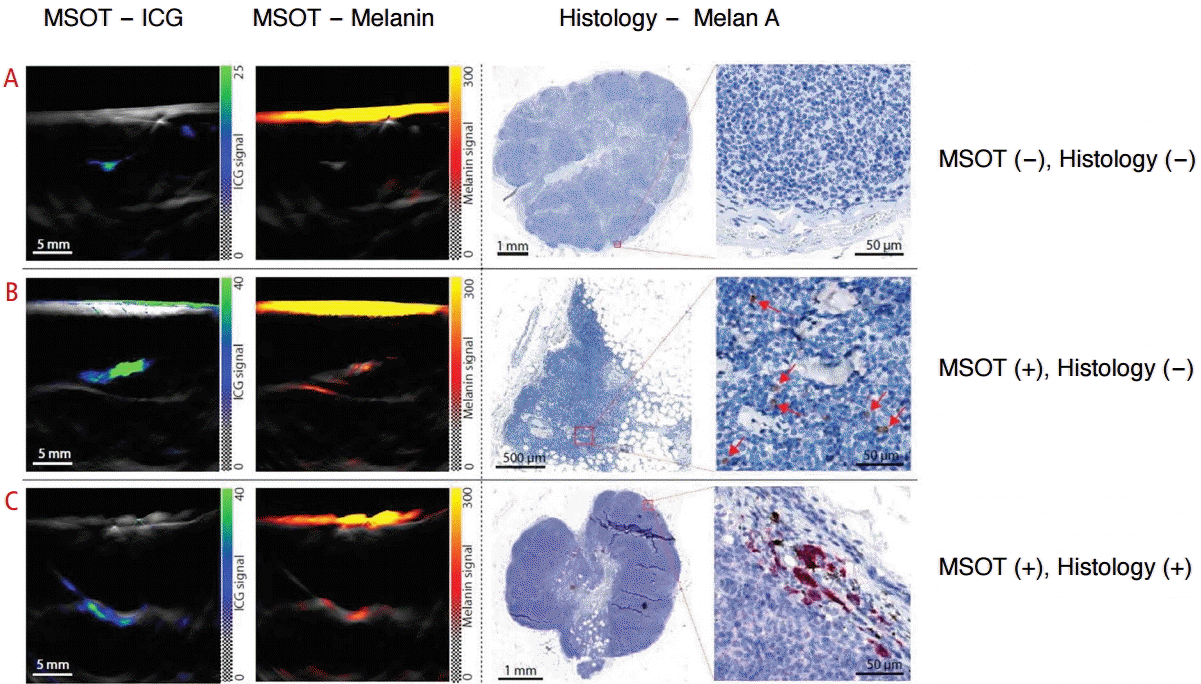
 Download Citation
Download Citation PDF Links
PDF Links PubReader
PubReader ePub Link
ePub Link Full text via DOI
Full text via DOI Full text via PMC
Full text via PMC




